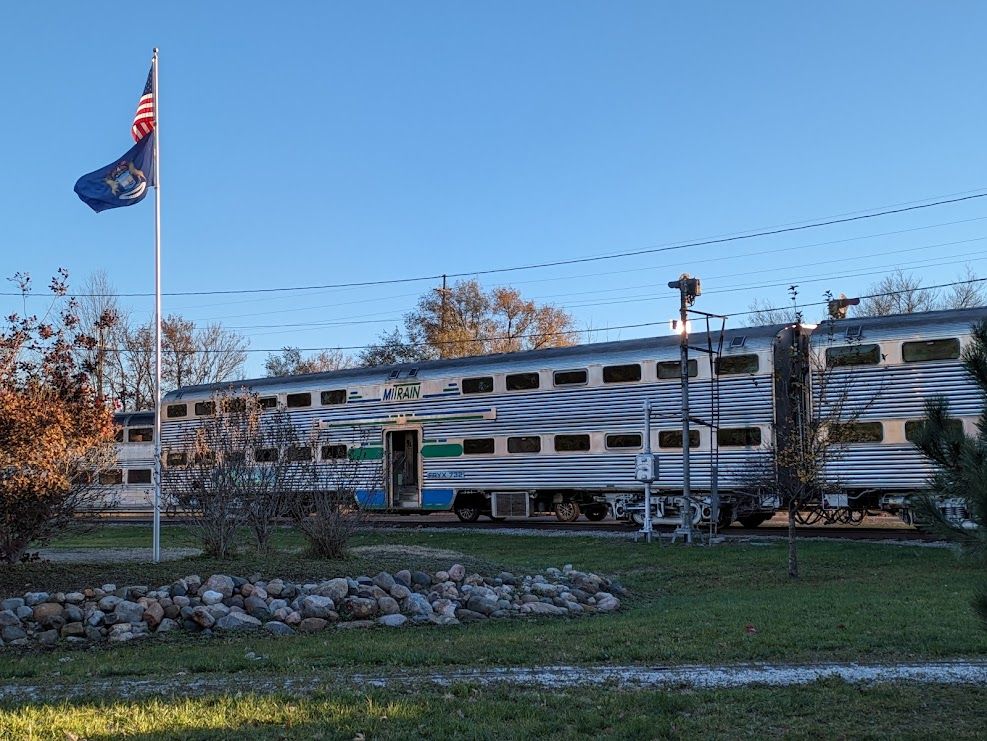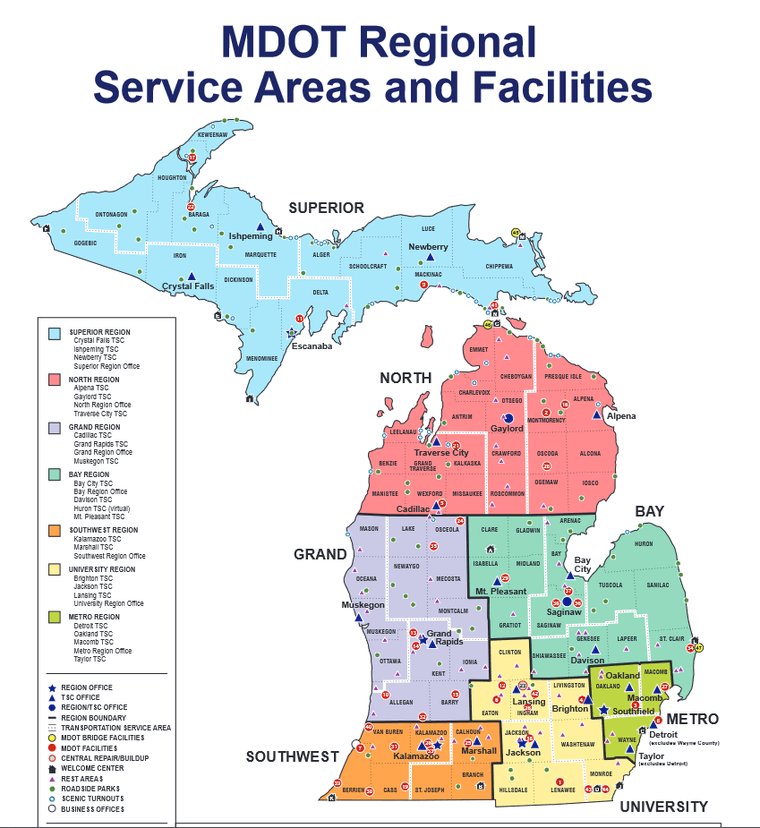102nd Legislature, Week 54: SOAR Reform, House Edition

Michigan’s most recent attempt at intercity rail was “MiTrain” between Ann Arbor and Detroit , which stalled out a decade ago and has sat dormant since awaiting proper funding. The ex-Metra cars can still be seen behind the Steam Railroading Institute in Owosso.
In March, a SOAR reform package was passed in the Senate. On Thursday, May 30th, the House introduced its own reform package consisting of three bills: HB 5768, HB 5769, and HB 5770. The bills are tie-barred with one another and with Senate Bills 559 and 562, indicating that the House package intends to complement efforts in the Senate rather than fully replace them.
Here’s the big picture as of Friday, May 31st. All bills have been referred to the House Committee on Economic Development and Small Business and are awaiting a hearing.
| Bill | Lead Sponsor | Summary |
|---|---|---|
| SB 559 | Sen. McMorrow (D-Royal Oak) | Renames SOAR to the Make it in Michigan Fund and creates the Michigan 360 Program |
| SB 562 | Sen. Cavanagh (D-Redford Twp) | Directs 50% of the Make it in Michigan Fund to Michigan 360 |
| HB 5768 | Rep. Hoskins (D-Southfield) | Extends and allocates SOAR fund through FY2034-35 fiscal year |
| HB 5769 | Rep. Morgan (D-Ann Arbor) | Creates a Transformational Projects Authority within MDOT |
| HB 5770 | Rep. McFall (D-Hazel Park) | Creates the Michigan Mobility Trust Fund |
SOAR Funds Extended through FY2034-35
The Senate SOAR reform redirected 50% of existing funds into a new “Michigan 360” program which would, among other placemaking efforts, fund regional transit expansion projects. This package did not, however, extend SOAR beyond its current end date of 2025. The House reform package renews SOAR for another ten years and creates a framework for dedicated, sustained transit project funds through both the Senate’s “Make it in Michigan” fund and a new “Michigan Mobility Trust Fund,” which will be overseen by a dedicated authority: The Transformational Projects Authority.
House Bill 5768 would allocate annual SOAR funds as follows beginning FY 2025-26:
- Up to $1.2B to the general fund
- Up to $100M to the Housing and Community Development Fund (HCDF)
- Up to $50M to the Revitalization and Placemaking Program (RAP)
- Up to $200M to the Michigan Mobility Trust Fund (HB 5770)
- Up to $250M to the Make it in Michigan Fund (SB 559)
Should the SOAR fund expire without renewal, funds will be deposited into the general fund.
The Transformational Projects Authority
Created by House Bill 5769 and funded by the Michigan Mobility Trust Fund established in House Bill 5770, this new authority would oversee, as the name suggests, “transformational mobility projects.” The TPA would be overseen by a five-member volunteer board appointed by the governor, at least two of which must have “expertise in public transportation” but shall not be employed by a public transportation provider. One seat will be a one-year term, one will be a two-year term, one a three-year term, and the remaining two, four-year terms to facilitate rolling representation initially. After these first appointments are termed out, subsequent appointments will all be four-year terms. As with all public bodies, meetings will be held in accordance with the Open Meetings Act.
20% of the funds allocated to the TPA would be reserved for supplemental operating grants to eligible Michigan transit providers and authorities (i.e., the RTA of Southeast Michigan and any future regional transit authority). Any funds received are in addition to funding from the state transportation budget, not a replacement; the legislation includes a provision eliminating this grant allocation should the state transportation budget (CTF) fall below its FY2024-25 level in the future. This effectively raises the floor for Local Bus Operations funding, a step toward avoiding a repeat of this year’s budget crisis .
Qualifying projects
The full text of the bill outlines what qualifies as a project.
For an MDOT region¹ with a population of 1 million or more that already has a rolling rapid transit system² OR for an MDOT region with a population under 1 million, projects will be deemed eligible and prioritized according to:
- Extent of support from local government, public transit providers, and other regional "anchor institutions" (employers)
- Degree of financial participation from regional entities (local governments, transit providers)
- Eligibility for a federal fixed guideway Capital Investment Grant³
- Locally or regionally significant benefits "with priority given to a qualified investment that includes a transit, multimodal, or nonmotorized component"
For an MDOT region with a population of 1 million or more that does not currently have a rolling rapid transit system operated by an existing provider, the TPA would fund and oversee the development, expansion, or enhancement of specific projects:
- Rolling rapid transit
- Commuter rail
- Intercity rail
- "Regional or multijurisdictional public transportation that connects major population, employment, health care, or other activity centers"
- "Innovative and flexible public transportation intended to meet mobility needs in lower density areas, for first and last mile transportation solutions, or for other specialized public transportation purposes, including, but not limited to, access to health care"
The criteria for projects in regions with existing service as described above would still be considered.
Notes
1. MDOT is organized into seven regions : Bay, Grand, Metro, North, Southwest, Superior, and University. The Metro region is functionally equivalent to the RTA footprint (Macomb, Oakland and Wayne counties) with population well over one million. The University (Lansing / Ann Arbor), Grand (Grand Rapids), and Bay (Bay City / Saginaw / Midland / Flint / Port Huron) regions also surpass this threshold.

The seven MDOT Regional Service Areas.
2. The RTA-enabling legislation defines a “rolling rapid transit system” as “bus services that may combine the technology of intelligent transportation systems, traffic signal priority, cleaner and quieter vehicles, rapid and convenient fare collection, and integration with land use policy.” It may include, but is not limited to, exclusive right-of-way (bus lanes), rapid boarding and alighting (e.g., all-door boarding, off-vehicle payment), and “integration with other modes of transportation.”
3. The Capital Investment Grants program from the FTA provides funding for projects deemed to be of “medium quality” or better. As the legislature has referenced on multiple occasions over the past two years, Southeast Michigan hasn’t met this standard. The Laker Line in Grand Rapids remains one of Michigan’s only transit services that approaches the standards of Bus Rapid Transit and successfully unlocked CIG funding.
My thoughts and interpretation
There are a lot of moving parts to this economic development package. In a nutshell: MDOT regions in Michigan with a lot of residents that currently don’t have adequate rapid transit would be prioritized in project selection.
The RTA-enabling legislation’s definition of a “rolling rapid transit system” is in essence a collection of components seen in a true Bus Rapid Transit system without actually calling it BRT, and thus not requiring a project deemed as such to meet the federal standards of BRT.
Even then, aside from the Laker Line in Grand Rapids, Michigan does not have any bus service that could be considered rolling rapid transit according to the RTA’s definition. In Metro Detroit, SMART operates FAST, which planners call “BRT-Lite” (limited-stop service) as it has none of the features outlined by the RTA. Lansing has no true rapid transit either – CATA’s BRT proposal was shelved in 2017 . This means that funding allocated through this bill package could be used to build and improve rail and rapid transit corridors in every major city in Michigan that falls within the Metro, University, and Bay MDOT regions. That’s the majority of the state’s population.
Keep in mind that the eligibility requirements are a guide, not an absolute: Rail projects and new corridors could still be proposed for areas with existing rolling rapid transit (Grand Rapids, debatably), but might be subject to more stringent and subjective review. Project selection would ultimately come down to the TPA Board of Directors. The TPA will sink or swim according to who the governor chooses to appoint, so we’ll need all of the relevant advocacy organizations on deck to submit quality recommendations to the administration.
Note that the long-awaited Detroit to Grand Rapids rail corridor is still actively being pursued independent of this SOAR package per recent conversations with the state legislature (though it is possible it may be funded in part through the Mobility Trust Fund).
As for the approach overall: I wasn’t familiar with SOAR beyond the name until two months ago, so I won’t pretend to have a fully-fledged opinion on the merits and success of the specific corporate incentives awarded through this program. I’ll say this much: It’s not a very conventional way to allocate such a significant amount of funding for public transit, and it’s certainly not how our peer states have approached it. Regardless, it’s good to see the legislature finally planning a substantial and sustained investment.
One could make the argument that SOAR, even despite these attempts to reform it, is geared towards attracting and subsidizing the automotive industry rather than new Michiganders with diverse career prospects. Having grown up in Genesee County in a UAW family, and speaking as myself, I can tell you that when Michigan fully caters to the wants of the Big Three it’s usually destructive. See: Chevy in the Hole , which took decades to redevelop from acres of hazardous waste into a park, and the recent loss of beloved Capitol Coney Island in the name of a surface parking lot for unsold trucks. Metro Detroit has plenty of its own examples of damage done by the mistakes of past automotive investment. Michigan cannot continue to allow automotive and manufacturing giants free rein, and I’m still not convinced the Whitmer administration will ever fully transition out of that old mindset.

A mural on the side of Capitol Coney Island on Bristol and Van Slyke in Flint, which was demolished in 2023. It was a favorite among third-shift workers in the Greater Flint Area.
But if sticking with SOAR is truly what needs to be done to permanently earmark funds for intercity rail and proper rapid transit projects in our current legislative body, let’s do it. Tethered to corporate interests as it may be, we can’t afford to leave this much money on the table. I’m along for the ride.